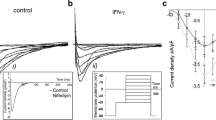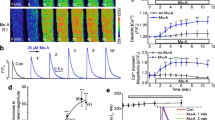Abstract
The Ca2+ antagonist mibefradil at supratherapeutic concentrations induced a sustained increase of cytosolic Ca2+ in cultured rat cardiac fibroblasts and human platelets which lack sensitivity to K+ depolarization and Ca2+ channel block by verapamil or other Ca2+ antagonists. At concentrations above 10 μM, mibefradil elevated substantially cytosolic [Ca2+] without affecting the peak level of agonist-induced Ca2+ transients. These Ca2+-mobilizing actions of 10 or 100 μM mibefradil stand in contrast to the Ca2+ antagonism and relaxation of vascular muscle at 1μM concentrations. Since a substantial part of mibefradil-induced increase in cytosolic Ca2+ was independent of extracellular Ca2+, and in order to define better the mechanism of Ca2+ increase, we exposed permeabilized cultured rat cardiac fibroblasts and human platelets to mibefradil at concentrations sufficiently high to identify covert effects. In permeabilized fibroblasts or platelets mibefradil at concentrations above 10 μM activated dose-dependent Ca2+ release from intracellular Ca2+ stores. Verapamil had no effect at concentrations of up to 100 μM. Mibefradil-induced Ca2+ release was not affected by ryanodine, thapsigargin, removal of ATP or dithioerythreitol, indicating that neither Ca2+- nor disulfide reagent-induced Ca2+ release were involved and that mibefradil did not release Ca2+ by inhibition of the Ca2+-ATPase pump of endoplasmic reticulum. The rate, but not the amplitude, of mibefradil-induced Ca2+ release is increased up to fourfold in the presence of pentosan polysulphate or heparin, two potent inhibitors of inositol 1,4,5-trisphosphate-induced Ca2+ release. Depletion of Ca2+ stores of permeabilized cells using inositol 1,4,5-trisphosphate in the presence of thapsigargin completely blocked mibefradil-induced Ca2+ release, and depletion of Ca2+ stores by mibefradil prevented further Ca 2+ release by inositol 1,4,5-trisphosphate. Mibefradil at supratherapeutic concentrations (≥/10 μM) thus mobilized Ca2+ from an inositol 1,4,5-trisphosphate-sensitive Ca2+ pool in cultured rat cardiac fibroblasts and human platelets.
Similar content being viewed by others
References
Adunyah SE, Dean WL (1986) Effects of sulfhydryl reagents and other inhibitors on Ca2+ transport and inositol trisphosphate-induced Ca2+ release from human platelet membranes. J Biol Chem 261:13071–13a075
Bezprozvanny IB, Ondrias K, Kaftan E, Stoyanovsky DA, Ehrlich, BE (1993) Activation of the calcium release channel (ryanodine receptor) by heparin and other polyanions is calcium dependent. Mol Biol Cell 4:347–352
Bian K, Hermsmeyer K (1993) Ca2+ channel actions of the non-dihydropyridine Ca2+ channel antagonist, Ro 40–5967, in vascular muscle cells cultured from dog coronary and saphenous arteries. Naunyn-Schmiedeberg's Arch Pharmacol 348:191–196
Bühler FR, Bolli P, Erne P, Kiowski W, Müller FB, Hulthey UL, Ji BH (1985) Position of calcium antagonists in hypertensive therapy. J Cardiovasc Pharmacol 7(suppl 4):S21-S27
Clozel J-P, Banken L, Osterrieder W (1989) Effects of Ro 40–5967, a novel calcium antagonist, on myocardial function during ischemia induced by lowering coronary perfusion pressure in dogs: comparison with verapamil. J Cardiovasc Pharmacol 14:713–721
Clozel J-P, Véniant M, Osterrieder W (1990) The structurally novel Ca2+ channel blocker Ro 40–5967, which binds to the [3H]desmethoxyverapamil receptor, is devoid of the negative inotropic effects of verapamil in normal and failing rat hearts. Cardiovasc Drugs Ther 4:731–739
Crabos M, Roth M, Hahn AWA, Erne P (1994) Characterization of angiotensin 11 receptors in cultured adult rat cardiac fibroblasts. J Clin Invest 93:2372–2378
Eberhard M (1990) A set of programs for analysis of kinetic and equilibrium data. Comp Appl Biosci 6:213–221
Eberhard M, Erne P (1991) Analysis of calcium binding to α-lactalbumin using a fluorescent calcium indicator. Eur J Biochem 202:1333–1338
Eberhard M, Erne P (1993) Inositol 1,4,5-trisphosphate-induced calcium release in permeabilized platelets is coupled to hydrolysis of inositol 1,4,5-trisphosphate to inositol 1,4-bisphosphate. Biochem Biophys Res Common 195:19–24
Eberhard M, Erne P (1994) Calcium and magnesium binding to rat parvalbumin. Eur J Biochem 222:21–26
Erne P, Mittelholzer E, Bürgisser E, Flückiger R, Bühler FR (1984) Measurement of receptor induced changes in intracellular free calcium in human platelets. J Recept Res 4:587–604
Ezzaher A, Bouanani NH, Su JB, Hittinger L, Crozatier B (1991) Increased negative inotropic effect of calcium-channel blockers in hypertrophied and failing rabbit heart. J Pharmacol Exp Ther 257:466–471
Fang LM, Osterrieder W (1991) Potential-dependent inhibition of cardiac Ca2+ inward currents by Ro 40–5967 and verapamil: relation to negative inotropy. Eur J Pharmacol 196:205–207
Grynkiewicz G, Poenie M, Tsien RY (1985) A new generation of Ca2+ indicators with greatly improved fluorescence properties. J Biol Chem 260:3440–3450
Hefti F, Clozel JP, Osterrieder W (1990) Antihypertensive properties of the novel calcium antagonist (1S,2S)-2-[2-[[3-(2-benzirnidazolyl)-propyl]methylamino]ethy]-6-fluor o-1,2,3,4-tetrahydro-l-isopropyl-2-naphtyl methoxyacetate dihydrochloride in rat models of hypertension. Comparison with verapamil. Arzneimittelforschung 40:417–421
Mehrke G, Zong XG, Flockerzi V, Hofmann F (1994) The Ca2+-channel blocker Ro 40–5967 blocks differently T-type and L-type Ca2+ channels. J Pharmacol Exp Ther 271:1483–1488
Mishra SK, Hermsmeyer K (1994a) Selective inhibition of T-type Ca2+ channels by Ro 40–5967. Circ Res 75:144–148
Mishra SK, Hermsmeyer K (1994b) Inhibition of signal Ca2+ in dog coronary arterial vascular muscle cells by Ro 40–5967. J Cardiovasc Pharmacol 24:1–7
Mishra SK, Hermsmeyer K (1994c) Resting state block and use of independence of rat vascular muscle Ca++ channels by Ro 40–5967. J Pharmacol Exp Ther 269:178–183
Orito K, Satoh K, Taira N (1993) Cardiovascular profile of Ro 405967, a new nondihydropyridine calcium antagonist, delineated in isolated, blood-perfused dog hearts. J Cardiovasc Pharmacol 22:293–299
O'Rourke FA, Halenda SP, Zavioco GB, Feinstein MB (1985) Inositol 1,4,5-trisphosphate releases Ca2+ from a Ca2+-transporting membrane vesicle fraction derived from human platelets. J Biol Chem 260:956–962
Osterrieder W, Holck M (1989) In vitro pharmacologic profile of Ro 40–5967, a novel Ca2+ channel blocker with potent vasodilator but weak inotropic action. J Cardiovasc Pharmacol 13:754–759
Portegies MCM, Schmitt R, Kraaij CJ, Braat SH, Gassner A, Hagemeijer F, Pozenel H, Prager G, Viersma JW, Wall EE van der et al (1991) Lack of negative isotropic effects of the new calcium antagonist Ro 40–5967 in patients with stable angina pectoris. J Cardiovasc Pharmacol 18:746–784
Reid JL, Meredith PA, Donnelly R, Elliott HL (1988) Pharmacokinetics of calcium anagonists.J Cardiovasc Pharmacol 12(suppl 7):22–26
Schmitt R, Kleinbloesem CH, Belz GG, Schroeter V, Feifel U, Pozenel H, Kirch W, Halabi A, Woittiez AJ, Welker HA, Brummelen P van (1992) Hemodynamic and Immoral effects of the novel calcium antagonist Ro 40–5967 in patients with hypertension. Clin Pharmacol Ther 52:314–323
Triggle DJ (1991) Calcium channel drugs: structure-function relations and selectivity of action. J Cardiovasc Pharmacol 18(suppl 10):S1-S6
Véniant M, Clozel J-P, Hess P, Wolfgang R (1991) Ro 40–5967, in contrast to diltiazem, does not reduce left ventricular contractility in rats with chronic myocardial infarction. J Cardiovasc Pharmacol 17:277–284
Welker HA, Eggers H, Kleinbloesem CH, Erb K, Breithaupt K, Butzer R, Belz GG (1989) Ro 40–5967: pharmacokinetics of a new calcium antagonist (abstract). Eur J Clin Pharmacol 36(suppl):A304
Wiltshire HR, Harris HR, Prior KJ, Kozlowski UM, Worth E (1992) Metabolism of calcium antagonist Ro 40–5967: a case history of the use of diode-array u.v. spectroscopy and thermospray-mass spectrometry in the elucidation of a complex metabolic pathway. Xenobiotica 22:837–857
Zaidi NF, Lagenaur CF, Abramson JJ, Pessah I, Salama G (1989) Reactive disulfides trigger Ca2+ release from sarcoplasmic reticulum via an oxidation reaction. J Biol Chem 264:21725–21736
Author information
Authors and Affiliations
Rights and permissions
About this article
Cite this article
Eberhard, M., Miyagawa, K., Hermsmeyer, K. et al. Effects of mibefradil on intracellular Ca2+ release in cultured rat cardiac fibroblasts and human platelets. Naunyn-Schmiedeberg's Arch Pharmacol 353, 94–101 (1995). https://doi.org/10.1007/BF00168921
Received:
Accepted:
Issue Date:
DOI: https://doi.org/10.1007/BF00168921




